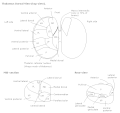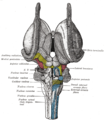Pulvinar nuclei
| Pulvinar nuclei | |
|---|---|
| Details | |
| Part of | thalamus |
| Identifiers | |
| Latin | nuclei pulvinares (the nuclei plurally); pulvinar thalami (the set of nuclei singularly) |
| MeSH | D020649 |
| NeuroNames | 328 |
| NeuroLex ID | birnlex_824 |
| TA98 | A14.1.08.104 A14.1.08.610 |
| TA2 | 5665, 5698 |
| FMA | 62178 |
| Anatomical terms of neuroanatomy] | |
The pulvinar nuclei or nuclei of the pulvinar (nuclei pulvinares) are the nuclei (cell bodies of neurons) located in the thalamus (a part of the vertebrate brain).[1] As a group they make up the collection called the pulvinar of the thalamus (pulvinar thalami), usually just called the pulvinar.
The pulvinar is usually grouped as one of the lateral thalamic nuclei in rodents and carnivores, and stands as an independent complex in primates.
Structure
By convention, the pulvinar is divided into four nuclei:
| TA alphanumeric identifier | TA name | English translation |
|---|---|---|
| A14.1.08.611 | nucleus pulvinaris anterior | anterior pulvinar nucleus |
| A14.1.08.612 | nucleus pulvinaris inferior | inferior pulvinar nucleus |
| A14.1.08.613 | nucleus pulvinaris lateralis | lateral pulvinar nucleus |
| A14.1.08.614 | nucleus pulvinaris medialis | medial pulvinar nucleus |
Their connectomic details are as follows:
- The lateral and inferior pulvinar nuclei have widespread connections with early visual cortical areas.
- The dorsal part of the lateral pulvinar nucleus predominantly has connections with dorsal streamcortical areas.
- The medial pulvinar nucleus has widespread connections with premotor and prefrontal cortical areas.[2]
- The pulvinar also has input from the superior colliculus to inferior, lateral and medial sections, which seems to be important in the initiation and compensation of saccade,[3][4] as well as the regulation of visual attention[5][6]
Clinical significance
Lesions of the pulvinar can result in
Other animals
The pulvinar varies in importance in different animals: it is virtually nonexistent in the rat, and grouped as the lateral posterior-pulvinar complex with the lateral posterior thalamic nucleus due to its small size in cats. In humans it makes up roughly 40% of the thalamus making it the largest of its nuclei.[15] Significant research has been undertaken in the marmoset examining the role of the retinorecipient region of the inferior pulvinar (medial subdivision), which projects to visual cortical area MT, in the early development of MT and the dorsal stream, as well as following early-life lesions of the primary visual cortex (V1).[16][17][18]
Etymology
The word pulvinar (/pʌlˈvaɪnər/) in Latin broadly means an armchair lined with numerous pillows. It was first neuroanatomically named by Karl Friedrich Burdach in 1817:[19] "The cushion (pulvinar), a swelling at the posterior end of the inner edge of the upper quadrigemina like a pillow over seats", English translation[20] (original German: "Das Polster (pulvinar), eine Anschwellung am hintern Ende des inner Randes der obern Vierhügel wie ein Kissen herüber legt"[19]). In Latin pulvinus could refer to "a sofa, cushioned seat, seat of honor, easy couch; of the couch or marriage-bed ", or more specifically, "a couch made of cushions, and spread over with a splendid covering, for the gods and persons who received divine honors; a couch or cushioned seat of the gods"[21] In the religion of ancient Rome, a pulvinar was an hetoimasia or empty throne, cushioned for occupation by a deity.[22] While anatomically, neuroanatomically there was no Roman deity between its arms, there was the pineal gland, that had in the 17th century, been identified by the French philosopher René Descartes as the seat of intellect and soul, and it has been suggested this link contributed to the first naming of this part of the brain by Karl Friedrich Burdach.[20]
References
- ^ Baud, RH; et al., "Latin index of TA98, Terminologia Anatomica version 1998", Federative International Programme on Anatomical Terminologies (FIPAT), International Federation of Associations of Anatomists (IFAA), hosted by the University of Fribourg (Switzerland)
- PMID 19150924.
- PMID 21228149.
- S2CID 7547426.
- S2CID 23143322.
- ^ Chalupa, L. (1991). Visual function of the pulvinar. The Neural Basis of Visual Function. CRC Press, Boca Raton, Florida, pp. 140-159.
- PMID 18669494.
- PMID 29298912.
- S2CID 207242249.
- PMID 30635570.
- PMID 33443074.
- S2CID 245553461.
- PMID 26912644.
- PMID 31795037.
- ISBN 978-0-12-601730-4p. 73
- PMID 23197701.
- PMID 20179789.
- PMID 25601551.
- ^ a b Burdach, K.F. (1817). Ueber die Aufgabe der Morphologie (in German). In der Dyk'schen Buchhandlung. Retrieved 2023-08-29.
- ^ ISSN 0940-9602.
- ^ "Charlton T. Lewis, Charles Short, A Latin Dictionary, pulvīnar". Perseus Digital Library. Retrieved 2023-08-29.
- ISSN 0350-1361.
Additional images
-
Thalamus
-
Deep dissection of brain-stem. Lateral view.
-
Dissection of brain-stem. Dorsal view.
-
Scheme showing central connections of the optic nerves and optic tracts.
-
Human brain left dissected midsagittal view
External links
- Stained brain slice images which include the "pulvinar" at the BrainMaps project
- Atlas image: eye_38 at the University of Michigan Health System - "The Visual Pathway from Below"





